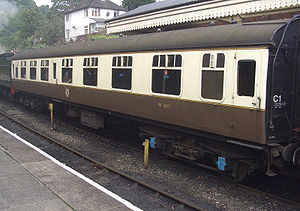- Composite Corridor
-
British Rail Composite Corridor 
W16071 CK at Llangollen on 28th August 2006In service 1952– Manufacturer BR Derby (C&W), Ashford, Eastleigh, and Wolverton Works; Birmingham Railway Carriage and Wagon Company, Charles Roberts, Cravens, Metro Cammell Family name British Railways Mark 1 Constructed 1952–1961 Number built 1268 Fleet numbers 15000–16227 Capacity 24 First, 18 or 24 Second Operator British Rail Specifications Car length 64 ft 6 in (19.66 m) Width 9 ft 3 in (2.82 m) Height 12 ft 9 1⁄2 in (3.90 m) Maximum speed BR1/Commonwealth: 90 mph (145 km/h),
B4: 100 mph (161 km/h)Weight 32–37 tonnes Bogies BR1, Commonwealth, or B4 Gauge 4 ft 8 1⁄2 in (1,435 mm) The Composite Corridor (or CK) is a railway coach with a number of compartments, some of which are standard class (previously second, né third class) and some first class, linked by a side corridor.
Contents
History
The composite coach was a standard coach design going back to the early days of railways, enabling a railway company to provide multi-class passenger accommodation in a single vehicle and so reduce costs. In the book "Red For Danger" by LTC Rolt it's mentioned that the train which came to grief at Wigan on the night of 2 August 1873 featured a Caledonian Railway composite coach[1]. Early composite coaches did not feature corridors or gangways between the vehicles.
Gangwayed stock
Once communicating gangways between coaches were introduced, a side corridor was provided to allow passengers and staff to walk up and down the train, while seated passengers in compartments were not disturbed, and thus the various types of side-corridor coaches were developed.
Non-gangwayed stock
In the BR Mk1 era, non-gangwayed composite coaches were constructed for use on suburban lines, these had a side corridor connecting all the compartments of one class to a central toilet, with a similar corridor connecting the compartments of the other class to a different toilet. Thus first class passengers could move between the first class compartments, and third/second class passengers likewise move about their area, but there was no communication between the classes or to adjacent coaches. A non-gangwayed Corridor Composite of this type, designated "C" (as opposed to CK for the gangwayed version), is preserved at the Keighley and Worth Valley Railway.
Big 4
All of the "Big 4" British railway companies created in the "Grouping" of 1923 operated Corridor Composite coaches.
BR Mk1 version
The British Railways Mark 1 CK, built from 1951 onwards, had four First-class and three Second-class compartments, with a vestibule separating the 1st and 2nd sections, and a sliding door (usually fixed open) to divide the corridor.
There were two variants, those built for the Midland, Scottish, and Eastern / North Eastern regions had six seats per compartment in 2nd class, with fold-up arm-rests which folded into the seat-back, while those built for the Southern and Western regions, with their heavy commuter loadings into London, had eight seats in each 2nd class compartment, and no arm-rests. 2nd class seating was of the interior sprung bench type.
All first class compartments sat six passengers, with folding arm rests which lifted into cushion dividers between the seats, using a lower bench with six individual square cushions on top for greater comfort.
In later years, as vehicles were re-allocated between regions, some had their arm-rests fixed in the folded position while on the Western region.
The CK was less common than coaches comprising all first class (FK) or all standard class (SK). There was also a Brake Composite Corridor or BCK, but this was not common.
No coaches of this type are still in daily use on the main line network, since open saloon coaches are now preferred by operating companies. Some do still run on heritage lines, as indicated in the Llangollen Railway picture above, with the North Yorkshire Moors Railway registering two examples for use on the Esk Valley Line between Whitby and Battersby.
References
See also
Coaching stock of British Rail Passenger coaches Mark 2:BFO · CO · FO · RFM · SLE · SLED · SLEP · TSO · TSOB - (Locomotive hauled)
TF · TGS · TRB · TRFB · TRFK · TRSB · TS - (InterCity 125 trailers)Other Mark 1:Categories:- British Rail coaching stock
Wikimedia Foundation. 2010.
